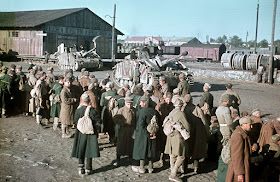Column of Red Army Prisoners in Ukraine are waiting for the transportation to the camp, 1943. Note the colour differences in the Soviet soldiers' coats and the German StuG (Sturmgeschütz) III assault guns, including three-colour camo in the back. It is estimated that at least 3.3 million Soviet POWs died in Nazi custody, out of 5.7 million. This figure represents a total of 57% of all Soviet POWs and may be contrasted with 8,300 out of 231,000 British and U.S. prisoners, or 3.6%. About 5% of the Soviet prisoners who died were Jews.[5] The most deaths took place between June 1941 and January 1942, when the Germans killed an estimated 2.8 million Soviet POWs primarily through deliberate starvation,[6] exposure, and summary execution. A million at most had been released, most of whom were so-called ‘volunteers’ (Hilfswillige) for (often compulsory) auxiliary service in the Wehrmacht, 500,000 had fled or were liberated, the remaining 3.3 million had perished as POWs. Photo by Schlosser.
Source :
https://en.wikipedia.org/wiki/German_mistreatment_of_Soviet_prisoners_of_war
http://www.ww2incolor.com/soviet-union/postug.html





